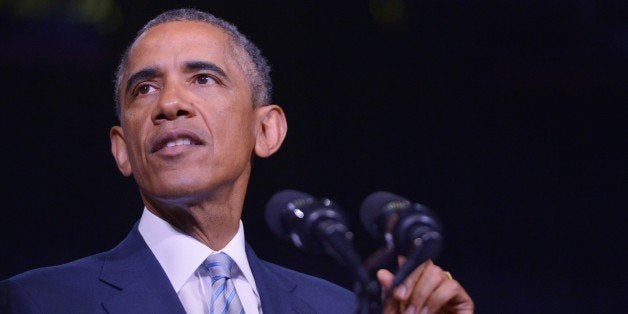
I'm all in favor of any plan to get more people to become more educated, and in particular, to help more people who live on the margins to get the educational tools they need to gain greater economic security. So, from that perspective, President Obama's "America's College Promise" proposal for "free" community college is a great idea! A similar program in Tennessee, the site of President Obama's announcement, is apparently hugely successful.
What could possibly go wrong with such a simple concept?
Plenty. Every gift horse has the potential of a few bad teeth, so we should not expect perfection in this or any governmental proposal. I'm less worried about a few bad teeth and more worried that the proposal is really a Trojan Horse that appears to offer needy students relief from tuition bills but that, in fact, comes loaded with hidden costs like more regulations and potential reduction in benefits for students who choose other kinds of institutions instead of community colleges.
America's College Promise could be great for many students if it does these things:
1. Encourage new enrollments: If the program really does encourage more people who otherwise would not go to college to get going on the pathway to higher learning, then great! All evidence points to the simple fact that more education improves earning potential across the lifespan. At the same time, if more workers get more advanced skills in the job training programs of community colleges, or get onto the pathway for more advanced learning in baccalaureate and graduate programs, then the national economy will reap the considerable benefits of a more educated workforce.
2. Reduce student debt: Depending on its structure, the plan has the potential to reduce student loan debt burdens by eliminating the need to take out loans for the first two years of college, thus reducing the overall cost of baccalaureate degrees for those students who choose to keep earning advanced credentials beyond job training certificates and associate degrees.
3. Solve Pell limitations: In the same way, the plan could contribute an important solution to the problem that low income students face due to arbitrary limits on Pell Grant eligibility -- Pell Grants currently do not support summer courses, and Pell eligibility tops out at 12 semesters, a myopic regulatory quirk that thwarts students who need longer periods of enrollment to complete major programs such as nursing and other credit-heavy degrees.
4. Reverse state disinvestment: During the last decade states have notoriously reduced their investments in higher education. By leveraging federal dollars as the lion's share of the tuition price for community colleges, this proposal could offer states the opportunity to re-invest dollars saved into their universities.
However, the gift horse becomes a Trojan Horse if the appearance of government largesse turns out to be a false front hiding reductions in federal support for students attending other kinds of institutions, or imposing new and more costly federal regulations. What are the dangers lurking inside of this popular idea?
1. Displacing existing enrollments: Rather than achieving the goal of educating more Americans, particularly those on the margins, the proposal could simply cannibalize existing enrollments in higher education, particularly attracting more middle-class and even wealthier students to choose community colleges to get the "free" benefits while doing little to increase the enrollment of students who might not otherwise go to college. Why would this happen? The proposal is a solution that begs a more thorough understanding of the problem it's trying to solve. For many low income students, the barriers to enrolling in college are not just about money -- yes, money is a big barrier, but not the only one -- but also family and work responsibilities, poor academic preparation and basic concerns like housing, food and transportation.
2. False advertising: Education is not "free." Education costs money well beyond tuition price. Unless this program is prepared to cover all costs of attendance, advertising this proposal as "free" education is a set-up for students who may not understand that they will still incur significant expenses to attend even community college.
3. Thwarting Pell Grant Improvements: If the proposal winds up displacing federal funds from other financial aid programs -- and particularly if it thwarts the need to keep improving Pell Grant benefits -- then it will harm millions of students enrolled in baccalaureate colleges and masters or research universities in the guise of offering "free" education to those in community colleges. Rather than offering a creative and more just solution to get everyone more educated, a plan that reduces other forms of federal financial aid will undermine the ultimate goals and betray the students who rely on federal aid across all types of institutions and all degree levels.
4. Increasing federal reach and regulation: Community colleges are traditionally part of state systems, and the funding and oversight of public higher education is a state responsibility. A federal takeover of state community colleges is a dramatic step toward federalizing higher education more completely at all levels, and invites an expanded level of regulation that would make the current regulatory nightmare look simple.
America's College Promise, while seeming like an extraordinary innovation on the surface, takes a very traditional view of higher education's structure at a time when higher education is changing somewhat dramatically on many campuses. Many public and private universities today educate exactly the same population that enrolls in community colleges, so the underlying assumption that students in one sector need and deserve support while others do not is simply wrong. Federal financial aid has never discriminated against students based on the kind of institution they attend. America's College Promise would change the structure of federal financial aid by favoring students enrolling in one sector while ignoring the reality of millions of low income students enrolled not only in public but also in private institutions.
Moreover, because of this problem with favoring the community college sector, the Obama proposal could have the unintended consequence of tracking low income students away from baccalaureate education, a perverse potential result that seems to work against the Administration's aggressive efforts in other venues to encourage more low income students to enroll in more elite institutions. For many students, the educational advantages of starting in baccalaureate education directly are considerable, and the lure of saving money by starting at the associate degree level could reduce, not increase, the ultimate educational outcomes for the nation.
Education is not free. A higher education has a value that should not be obscured by the sheer populism of this kind of proposal. While many students certainly need support to advance in education beyond high school, the Administration must be careful not to send a message of devaluing higher learning by labeling something as "free" that should require consumer investment along with public support. The Administration must also be careful to avoid the appearance of dumbing-down all of higher education by suggesting that students really only need the first two years, that the rest is not so important.
If the dangers inherent in this proposal can be addressed, then it certainly has the potential to be the kind of game-changer that many supporters are claiming it will be. Community colleges do great work and certainly deserve an honored place in higher education, and this proposal would solidify their clear value for many students. But student options and choices about where to start on the pathway to post-secondary degrees should be based on learning opportunities and not simply the message of "free."
